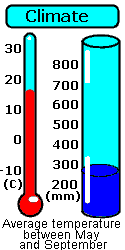









|
|
The Dry Mixedgrass Climate
 Climatically speaking, the Dry Mixedgrass Subregion is the warmest and driest in Alberta. It has a typical
continental climate with cold winters, warm summers and low
precipitation. Due to the warm summer temperatures and a high average wind speed, the rate of evaporation is high
and the average temperature typically hovers around 16 degrees Celsius.
Climatically speaking, the Dry Mixedgrass Subregion is the warmest and driest in Alberta. It has a typical
continental climate with cold winters, warm summers and low
precipitation. Due to the warm summer temperatures and a high average wind speed, the rate of evaporation is high
and the average temperature typically hovers around 16 degrees Celsius.
The total annual precipitation in this particular area is around 260-280
millimeters while summer precipitation is the lowest of any Subregion in Alberta. Compared to other Subregions, the Dry Mixedgrass Subregion has a high year-to-year precipitation
variability. Spring is usually the wettest season with about two-thirds of the annual precipitation falling as rain,
most of this occurring during the month of June. During the winter
months, however, the amount of snow cover is relatively low as is the number of days of continuous snow cover.
Chinooks are most common along the western border of the subregion where there are more than 30
Chinook days per year.
Information provided by and printed with the permission of Alberta
Community Development, Parks
and Protected Areas.
[Geology
and Landforms][Climate][Soils]
[Vegetation][Wildlife]
|
 Heritage Community Foundation Presents
Heritage Community Foundation Presents











 Climatically speaking, the Dry Mixedgrass Subregion is the warmest and driest in Alberta. It has a typical
Climatically speaking, the Dry Mixedgrass Subregion is the warmest and driest in Alberta. It has a typical